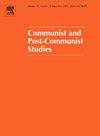Coercive Labor in the Cotton Harvest in the Xinjiang Uyghur Autonomous Region and Uzbekistan
IF 1.3
4区 社会学
Q3 INTERNATIONAL RELATIONS
引用次数: 2
Abstract
This study traces the evolution of systemic state-sponsored coercive labor in the cotton harvest in China’s northwestern Xinjiang Uyghur Autonomous Region (XUAR). The recent situation in the XUAR is compared to Uzbekistan, which implemented forced labor in cotton picking until 2021. Both regions create structurally coercive labor environments through a centralized authoritarian state apparatus that deploys human resource–intensive local grassroots mobilization efforts. The article finds that while both regional entities’ coercive labor dynamics are in many ways comparable, the resulting labor settings are not easily captured through static standard measures such as the ILO forced labor indicators. Instead, state-sponsored forced labor is characterized by pervasive state-induced and systemic dynamics of coercion that are deeply embedded within sociocultural contexts. Whereas Uzbekistan’s coercive labor practices were primarily driven by economic considerations, Xinjiang’s labor transfer program pursues some economic aims but is predominantly designed to achieve Beijing’s wider ethnopolitical goals in the region.新疆维吾尔自治区和乌兹别克斯坦棉花收获中的强制劳动
本研究追溯了中国西北部新疆维吾尔自治区(XUAR)棉花收获中国家支持的系统性强制劳动的演变。新疆维吾尔自治区最近的情况与乌兹别克斯坦进行了比较,乌兹别克斯坦在2021年之前在棉花采摘中实施强迫劳动。这两个地区都通过中央集权的国家机器,部署人力资源密集型的地方基层动员努力,在结构上创造了强制性的劳动环境。文章发现,虽然这两个地区实体的强制劳动动态在许多方面具有可比性,但由此产生的劳动环境不容易通过国际劳工组织强迫劳动指标等静态标准措施来衡量。相反,国家支持的强迫劳动的特点是普遍存在的国家诱导和系统的强制动力,深深植根于社会文化背景中。乌兹别克斯坦的强制劳动实践主要是出于经济考虑,而新疆的劳动力转移计划追求一些经济目标,但主要是为了实现北京在该地区更广泛的民族政治目标。
本文章由计算机程序翻译,如有差异,请以英文原文为准。
求助全文
约1分钟内获得全文
求助全文
来源期刊

Communist and Post-Communist Studies
Multiple-
CiteScore
1.90
自引率
0.00%
发文量
23
期刊介绍:
Communist and Post-Communist Studies is an international journal covering all communist and post-communist states and communist movements, including both their domestic policies and their international relations. It is focused on the analysis of historical as well as current developments in the communist and post-communist world, including ideology, economy and society. It also aims to provide comparative foci on a given subject by inviting comments of a comparative character from scholars specializing in the same subject matter but in different countries.
 求助内容:
求助内容: 应助结果提醒方式:
应助结果提醒方式:


